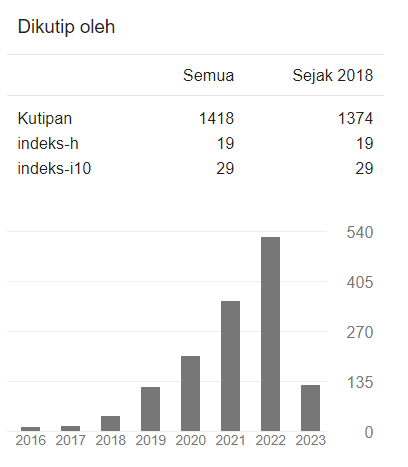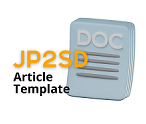Tantangan dan Strategi Penerapan Berpikir Kritis pada Pembelajaran Online: Kajian Pustaka
DOI:
https://doi.org/10.22219/jp2sd.v10i2.22308Abstract
Technological and critical thinking skills are two essential aspects of learning. The rapid development of technology and the demands of competition in the era of globalization force educators to be truly effective in maximizing existing and current learning technologies. Implementing online learning is believed to be inadequate without the ability to think critically. Critical thinking is an ability that is essentially needed for students in the present context. This paper discusses the challenges and strategies for applying critical thinking for students in online learning using a literature study approach. The study found that online learning can be an excellent tool to help students improve their critical thinking skills. The study also found that, despite the various challenges faced, critical thinking skills must still be encouraged and implemented in online learning because critical thinking skills will help students analyze their thoughts which will be the basis for making a choice and help them conclude. Implications and suggestions for further research are presented.
Downloads
References
Aizikovitsh, E., & Amit, M. (2010). Evaluating an infusion approach to the teaching of critical thinking skills through mathematics. Procedia - Social and Behavioral Sciences, 2(2). https://doi.org/10.1016/j.sbspro.2010.03.596
Arend, B. (2009). Encouraging Critical Thinking in Online Threaded Discussions. In The Journal of Educators Online (Vol. 6, Issue 1).
As’ari, A. R., Mahmudi, A., & Nuerlaelah, E. (2017). Our prospective mathematic teachers are not critical thinkers yet. Journal on Mathematics Education, 8(2). https://doi.org/10.22342/jme.8.2.3961.145-156
Aslam, R., Khan, N., Asad, M. M., & Ahmed, U. (2021). Impact of technological pedagogical content knowledge on teachers’ digital proficiency at classroom in higher education institution of Pakistan. Interactive Technology and Smart Education, 18(1), 119–130. https://doi.org/10.1108/ITSE-11-2020-0222
Bai, H. (2009). Facilitating Students’ Critical Thinking in Online Discussion: An Instructor’s Experience. Journal of Interactive Online Learning Www.Ncolr.Org/Jiol, 8(2). www.ncolr.org/jiol
Birjandi, P., & Bagherkazemi, M. (2010). The Relationship between Iranian EFL Teachers’ Critical Thinking Ability and their Professional Success. English Language Teaching, 3(2), 135–145. www.ccsenet.org/elt
Carmichael, E., & Farrell, H. (2012). Evaluation of the Effectiveness of Online Resources in Developing Student Critical Thinking: Review of Literature and Case Study of a Critical Thinking Online Site. Journal of University Teaching and Learning Practice, 9(1), 38–55. https://doi.org/10.53761/1.9.1.4
Chang, Y. S. (2013). Student technological creativity using online problem-solving activities. International Journal of Technology and Design Education, 23(3). https://doi.org/10.1007/s10798-012-9217-5
Changwong, K., Sukkamart, A., & Sisan, B. (2018). Critical thinking skill development: Analysis of a new learning management model for Thai high schools. Journal of International Studies, 11(2), 37–48. https://doi.org/10.14254/2071
Davies, M. (2015). A Model of Critical Thinking in Higher Education. https://doi.org/10.1007/978-3-319-12835-1_2
Ennis, R. H. (2011). The nature of critical thinking: An outline of critical thinking dispositions and abilities. Presentation at the Sixth International Conference on Thinking at MIT, Cambridge, MA, July, 1994. Faculty.Education.Illinois.Edu.
Erikson, M. G. (2019). Supporting critical thinking in higher education: Consideration for strategic discussions. Paper Presented at the 2019 European Learning & Teaching Forum of European University Association, University of Warsaw, Warsaw., 23–35.
Foo, S. Y., & Quek, C. L. (2019). Developing Students’ Critical Thinking through Asynchronous Online Discussions: A Literature Review. Malaysian Online Journal of Educational Technology, 7(2).
Ghaani, M., & Roslin, V. P. (2021). A Study on the Knowledge, Attitude, and Practice of Critical Thinking Skills among EFL Teachers in Iran. 3(2), 14–24. https://doi.org/10.47176/kurmanj.3.2.14
Goodsett, M. (2020). Best practices for teaching and assessing critical thinking in information literacy online learning objects. Journal of Academic Librarianship, 46(5). https://doi.org/10.1016/j.acalib.2020.102163
Habiburrahim, H. (2016). The Internet and ICT: Opportunities or Threats to the Education World? Englisia Journal, 3(1). https://doi.org/10.22373/ej.v3i1.533
Hadjerrouit, S. (2017). Using an understanding of the learning cycle to build effective e-Learning. In Advanced principles of effective e-Learning (pp. 27–58). Santa Rosa, CA: Informing Science Press.
Harvey, A., & Kamvounias, P. (2008). Bridging the implementation gap: a teacher‐as‐learner approach to teaching and learning policy. Http://Dx.Doi.Org/10.1080/07294360701658716, 27(1), 31–41. https://doi.org/10.1080/07294360701658716
Hasan, S., Tumbel, F. M., & Duran Corebima, A. (2013). Empowering Critical Thinking Skills in Indonesia Archipelago: Study on Elementary School Students in Ternate. Journal of Modern Education Review, 3(11).
Heong, Y. M., Ping, K. H., Hamdan, N., Ching, K. B., Yunos, J. M., Mohamad, M. M., Jiar, Y. K., & Azid, N. (2020). Integration of learning styles and higher order thinking skills among technical students. Journal of Technical Education and Training, 12(3 Special Issue). https://doi.org/10.30880/jtet.2020.12.03.018
Hew, K. F. (2016). Promoting engagement in online courses: What strategies can we learn from three highly rated MOOCS. British Journal of Educational Technology, 47(2). https://doi.org/10.1111/bjet.12235
Indah, R. N., & Kusuma, A. W. (2016). Factors Affecting The Development of Critical Thinking of Indonesian Learners of English Language. IOSR Journal Of Humanities And Social Science (IOSR-JHSS, 21(6).
Jang, S. J. (2009). Exploration of secondary students’ creativity by integrating web-based technology into an innovative science curriculum. Computers and Education, 52(1). https://doi.org/10.1016/j.compedu.2008.08.002
Kinne, L., & Eastep, S. M. (2011). Instructional Design in Online Learning : Components of Quality. Kentucky Journal of Excellence in College Teaching and Learning, 6(2008).
Krulik, & Rudnick. (1995). The new sourcebook for teaching reasoning and problem solving in elementary school. Boston: Temple University.
López-Pérez, M. V., Pérez-López, M. C., & Rodríguez-Ariza, L. (2011). Blended learning in higher education: Students’ perceptions and their relation to outcomes. Computers and Education, 56(3). https://doi.org/10.1016/j.compedu.2010.10.023
Lunney, M., Frederickson, K., Spark, A., & McDuffie, G. (2019). Facilitating Critical Thinking Through Online Courses. Online Learning, 12(3–4). https://doi.org/10.24059/olj.v12i3-4.1686
Macknight, C. (2000). Teaching critical thinking through online discussions. Educause Quarterly, 4.
Mandernach, B. J., Forrest, K. D., Babutzke, J. L., & Manker, L. R. (2009). The role of instructor interactivity in promoting critical thinking in online and face-to-face classrooms. Merlot Journal of Online Learning and Teaching, 5(1), 49–62.
Osborne, D. M., Byrne, J. H., Massey, D. L., & Johnston, A. N. B. (2018). Use of online asynchronous discussion boards to engage students, enhance critical thinking, and foster staff-student/student-student collaboration: A mixed method study. Nurse Education Today, 70. https://doi.org/10.1016/j.nedt.2018.08.014
Pahl, C. (2004). Data mining technology for the evaluation of learning content interaction. International Journal on E-Learning, 3 (4).
Pane, N., Syahputra, E., & Mulyono, M. (2018). Improving the Ability of Creative Thinking Mathematically and Self-Confidence Student through Application Model Eliciting Activities (MEAs) Review from Student Gender. American Journal of Educational Research, 6(4). https://doi.org/10.12691/education-6-4-4
Paré, G., Trudel, M. C., Jaana, M., & Kitsiou, S. (2015). Synthesizing information systems knowledge: A typology of literature reviews. Information & Management, 52(2), 183–199. https://doi.org/10.1016/J.IM.2014.08.008
Phirangee, K., Epp, C. D., & Hewitt, J. (2016). Exploring the relationships between facilitation methods, students’ sense of community, and their online behaviors. Online Learning Journal, 20(2). https://doi.org/10.24059/olj.v20i2.775
Puspitasari, L., In’am, A., & Syaifuddin, M. (2018). Analysis of Students’ Creative Thinking in Solving Arithmetic Problems. International Electronic Journal of Mathematics Education, 14(1). https://doi.org/10.12973/iejme/3962
Rabu, S. N. A., Aris, B., & Tasir, Z. (2013). Teaching Critical thinking through Online Instructor Scaffolding: A Conceptual Framework. Procedia - Social and Behavioral Sciences, 97. https://doi.org/10.1016/j.sbspro.2013.10.239
Rachmadyanti, P. (2021). Persepsi Mahasiswa PGSD tentang Penggunaan Padlet pada Pembelajaran Microteaching. Jurnal Pemikiran Dan Pengembangan Sekolah Dasar), 9(2), 103–115. https://doi.org/10.22219/jp2sd.v9i2.17105
Rafiah, H., & Huriaty, D. (2021). Creativity of Elementary School Students Based on The Description Text Writing Skill. Jurnal Pemikiran Dan Pengembangan Sekolah Dasar, 9(2), 189–197. https://doi.org/10.22219/jp2sd
Ricci, F. A. (2013). Encouraging critical thinking in distance learning: ensuring challenging intellectual programs. Distance Learning VO - 10, 10(1).
Ruth, C. C., & Mayer, R. E. (2008). e-Learning and the Science of Instruction :Proven Guidelines for Consumers and Designers of Multimedia Learning (2nd ed.). In San Fransisco, CA, USA.
Sadeghi, F., Mohammad, S., Adel, R., Zareian, G., & Davoudi, M. (2020). Iranian EFL Teachers’ and Learners’ Perceptions of the Principles of Critical Thinking: A Constructivist Grounded Theory Study. Iranian Journal of Language Teaching Research, 8(2), 63–81. http://ijltr.urmia.ac.ir
Saleh, S. E. (2019). Critical Thinking as A 21st Century Skill: Conceptions, Implementation and Challenges in the EFL Classroom. European Journal of Foreign Language Teaching, 4(1), 1–16. https://doi.org/10.5281/zenodo.2542838
Silalahi, R. M. (2017). Assessing University Students’ Critical Thinking Skill by Using the TOEFL ITP Reading Test. Lingua Cultura, 11(2), 79. https://doi.org/10.21512/lc.v11i2.1518
Stapleton, P. (2001). Assessing critical thinking in the writing of Japanese university students: Insights about assumptions and content familiarity. Written Communication, 18(4). https://doi.org/10.1177/0741088301018004004
Subkhan, E. (2012). Paradigm Shifts on Educational Technology and its Posibilities for Transformative Action. The First International Conference on Current Issues in Education (ICCIE). https://www.researchgate.net/publication/335755742_Paradigm_Shifts_on_Educational_Technology_and_its_Posibilities_for_Transformative_Action
Tathahira, T. (2020). Promoting students’ critical thinking through online learning in higher education: Challenges and strategies. Englisia: Journal of Language, Education, and Humanities, 8(1), 79–92. https://doi.org/10.22373/EJ.V8I1.6636
Taula, R., A1, S., & Angreni, S. (2021). Peningkatan Kemampuan Berpikir Kritis Mahasiswa PGSD dalam Pembelajaran IPA Menggunakan Penuntun Pratikum Berbasis Inkuiri Terbimbing. Jurnal Pemikiran Dan Pengembangan Sekolah Dasar), 9(1), 40–47. https://doi.org/10.22219/jp2sd.v9i1.14124
Downloads
Published
Issue
Section
License
Copyright (c) 2022 Jurnal Pemikiran dan Pengembangan Sekolah Dasar (JP2SD)

This work is licensed under a Creative Commons Attribution-ShareAlike 4.0 International License.
Authors who publish with Jurnal Pemikiran dan Pengembangan Sekolah Dasar (JP2SD) agree to the following terms:
- For all articles published in Jurnal Pemikiran dan Pengembangan Sekolah Dasar (JP2SD), copyright is retained by the authors. Authors give permission to the publisher to announce the work with conditions. When the manuscript is accepted for publication, the authors agree to automatic transfer of the publishing right to the publisher.
- Authors retain copyright and grant the journal right of first publication with the work simultaneously licensed under a Creative Commons Attribution-ShareAlike 4.0 International License that allows others to share the work with an acknowledgment of the work's authorship and initial publication in this journal.
- Authors are able to enter into separate, additional contractual arrangements for the non-exclusive distribution of the journal's published version of the work (e.g., post it to an institutional repository or publish it in a book), with an acknowledgment of its initial publication in this journal.
- Authors are permitted and encouraged to post their work online (e.g., in institutional repositories or on their website) prior to and during the submission process, as it can lead to productive exchanges, as well as earlier and greater citation of published work (See The Effect of Open Access).

This work is licensed under a Creative Commons Attribution-ShareAlike 4.0 International License.


















